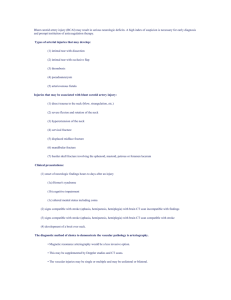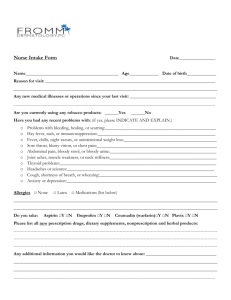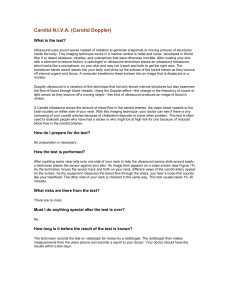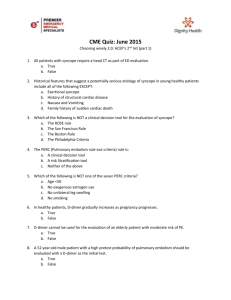An interesting case of syncope
advertisement
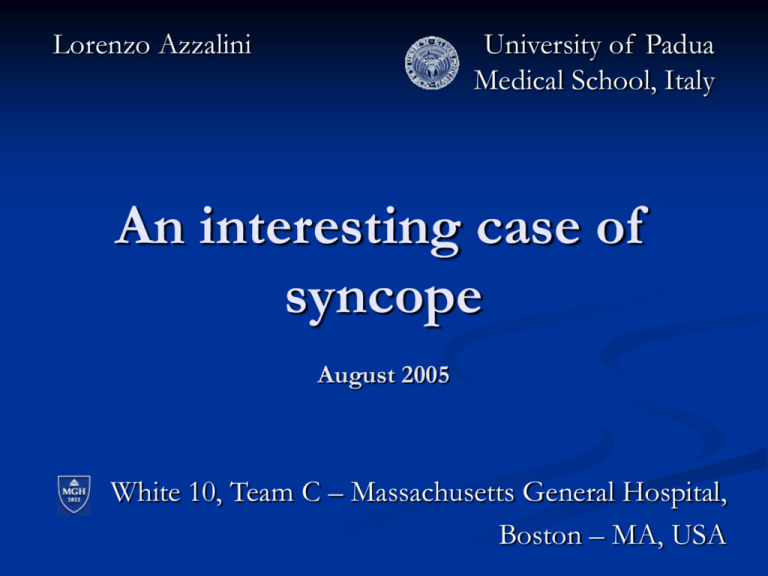
Lorenzo Azzalini University of Padua Medical School, Italy An interesting case of syncope August 2005 White 10, Team C – Massachusetts General Hospital, Boston – MA, USA History of present illness DAK is a 78 y.o. male with history of CAD, PE, recurrent DVT, COPD, DM, presenting with syncope. The pt. reports that he was in his usual state of health on the morning of the admission. He took his medications but had not yet eaten breakfast, and he was sitting in his chair. He stood up from the chair, took two steps, and the next thing he remembers is that he was hanging onto his TV, after having fallen forward onto it. He noticed pain in his head and in his L leg. After this loss of consciousness, the pt. reported feeling dizzy, confused and having difficulties walking. He denied chest pain, palpitations, SOB, nausea, vomiting or diaphoresis. History of present illness The pt. called EMS, who transported him to the MGH ED. There, he had a laboratory evaluation that revealed –ve cardiac enzymes, no significant electrolytes abnormalities, no urinary infections, and INR of 2.9 (he is taking Coumadin for recurrent DVTs). His pacemaker was funcioning normally, without any recorded events the morning of the admission to explain the syncope. History of present illness Chest x-ray showed cardiomegaly. Head CT did not reveal any acute bleeding. Plain x-rays of the left leg showed no fractures. The patient was then admitted for further workup of his syncope. At the admission on White 10, he denied any pain, except in his L leg, stated that he felt “a little light-headed”, and reported that he was unsure of getting up and walking, because of unsteadiness and fear of the L leg injury. History of present illness The pt. reports that he has only had one episode like this in the past, a little less than a year ago, when he went into an atrial arrythmia. He denied orthopnea, PND, history of stroke or any symptoms of weakness, but reported SOB on exertion after walking for a small distance. He reported that he had had several occasions where he had noticed that he felt to his left side when walking. These episodes resolved on their own and happened infrequently. Review of systems No fever, chills, nausea, vomiting, chest pains, palpitations. No orthopnea/PND. No cough/hemoptysis/wheezing/sore throat/rash. No hematochezia/melena. No alterations of mental status. No slurring of speech or unilateral weakness. No dysuria. No exposures/ingestions/recent travel. Past medical history CAD – Angiography (2/2000), showing diffuse coronary disease, without focal stenosis. Echo (10/2004), showing EF 57% with LVH and without wall motion abnormalities or significant valvular disease. Dipyridamole MIBI 3/2005, showing normal myocardial perfusion and LVEF 46%. Past medical history Atrial fibrillation – s/p ablation. With pacemaker (VVIR). Interrogation on admission showed AF with ventricular rate of 30 bpm. PE/DVTs – Pulmonary embolism (1970), history of recurrent DVTs. On chronic Coumadin. IVC filter. DM – oral therapy and diet. Controlled. COPD Glaucoma Past medical history s/p cornea transplant s/p appendectomy s/p hemorrhoidectomy Cholelithiasis Medications on admission Rosuvastatin (Crestor) 20 mg QD Glipizide 5 mg QD Pantoprazole (Protonix) 40 mg QD Warfarin (Coumadin) 10 mg QAM Isosorbide mononitrate sustained release 120 mg QD ASA 325 mg QD Atenolol 50 mg QD Medications on admission Furosemide (Lasix) 20 mg QD Lisinopril 20 mg QD Beclomethasone nasal spray one puff BID Albuterol PRN Allergies – past history of nausea on penicillin, but on admission the pt. claims he had no problems with penicillin. Social history – History of heavy drinking and smoking (120 pack-year), but quitted 35 years ago. Used to work as a Merchant Marine and commercial fisherman. Originally from Ireland. Widow. Lives alone. Familial history – Father died of MI, mother of “booze”, brothers of lung cancer. Physical exam Vital signs – T 96.6, HR 60, BP 144/80, RR 20, SaO2 99% RA Orthostatics – supine BP 115/62, HR 62; sitting BP 126/75, HR 66; standing BP 124/71, HR 70 General – obese, non-apparent distress HEENT – PERRL, EOMI, sclera anicteric Neck – supple, left mass, no carotid bruits, JVP difficult to appreciate Nodes – no cervical or supraclavicular LAD CV – RRR, S1 & S2 nl, 1/6 systolic murmur heard best at LUSB. No S3, S4. Physical exam Chest – fine crackles at L base, poor air movement bilaterally, otherwise CTA. Abdomen - +BS, NT, ND. No HSM. No peritoneal signs. Ext – 1+ edema bilaterally w/ evidence of chronic venous stasis changes, hematoma L knee Skin – no rashes Neuro – A&Ox3; CN II-XII intact, Romberg –ve, FTN showed dysmetria, poor rapid alternating movements. Labs and studies Blood Na+ 140 (135-145) mmol/l K+ 4.7 (3.4-4.8) mmol/l Cl- 110 (H) (100-108) mmol/l CO2 26.3 (23.0-31.9) mmol/l BUN 30 (H) (8-25) mg/dl Creatinine 1.3 (0.6-1.5) mg/dl Glucose 97 (70-110) mg/dl Labs and studies Blood CK-MB Negative Negative Troponin-I Negative Negative Labs and studies Blood RBC 4.17 (L) (4.50-5.90) ·109/mm3 HCT 36.5 (L) (41.0-53.0) % Hb 11.5 (L) (13.5-17.5) g/dl MCV 88 (80-100) fl MCH 27.5 (26.0-34.0) pg MCHC 31.4 (31.0-37.0) g/dl RDW 15.1 (H) (11.5-14.5) % Labs and studies Blood WBC 7.5 (4.5-11.0) ·103/mm3 PLT 168 (150-350) ·103/mm3 PT 21.3 (H) (11.3-13.3) s APTT 39.7 (H) (22.1-35.1) s Labs and studies Urine Specific gravity 1.025 (1.001-1.035) pH 5.5 (5.0-9.0) WBC screen Negative Negative Nitrite Negative Negative Albumin 3+ Negative Glucose Trace Negative Ketones Negative Negative Occult blood Trace Negative kg/l Chest X-Ray Chest X-Ray Stable moderate cardiomegaly, with no evidence for pulmonary edema. Head CT Head CT No evidence of traumatic injury or acute intracranial pathology. ECG V-paced HR 60 No underlying coordinated atrial depolarization Assessment and plan DAK is a 78 y.o. male with history of CAD, AF, PE/DVTs, on chronic coumadin, with syncopal episode and fall on the day of admission. 1) Syncope The patient’s history points towards orthostatic syncope. The pt. continued to have some dizziness even though he was not orthostatic when he arrived at White 10, which lessens the likelihood that orthostasis will be able to explain the whole picture. Arrythmia is not likely the cause of the syncope, as the pacemaker did not show any abnormal events. Neurologic etiology could be possible. Head CT was –ve for acute process, but the patient did have suspicious signs and symptoms (dizziness, dysmetria, gait difficulty) Assessment and plan Plan Central telemetry overnight 250 cc bolus (normal saline) Transcranial doppler to evaluate posterior circulation Assessment and plan 2) Heart Rhythm – monitor for any arrythmias Pump – last Echo revealed an EF of 57%. The patient does not clinically appear to be in heart failure (no pulmonary edema on CXR, JVP difficult to appreciate), but does have peripheral edema and SOB on exertion (though confunded by COPD). Continue beta-blocker, ACE-i and Lasix as at home Ischemia – no CP, first set of enzymes –ve. Continue monitoring enzymes. Assessment and plan 3) L leg pain The patient has difficulty walking due to his recent injury. Plan Tylenol or Percocet for pain as needed PT consult to assist the patient with walking and rehabilitation from injury Assessment and plan 4) Anticoagulation The patient is chronically on Coumadin. Plan Continue Coumadin and monitor INR Assessment and plan 5) COPD Plan Advair BID nad Albuterol PRN On further testing Carotid duplex US revealed mass in the neck on the left, recommended neck CT Neck CT revealed neck mass compressing the internal carotid artery. Neck vascular US Neck vascular US Large hypoechoic lesion in the left carotid space, displacing the internal jugular vein anteriorly and the left common carotid artery posteriorly and medially. This lesion, due to its echogenicity may correspond to schwannoma, lipoma, less likely muscle-derived tumor. This lesion may compress several cranial nerves, such as vagus or glossopharyngeal and may be the origin of the patient’s syncopal episode. Neck CT Neck CT Neck CT Large lipoma arising within the left carotid sheath, with mild compression of the supraglottic larynx and marked compression of the left internal jugular vein. Atherosclerotic disease with approximately 50% narrowing of the proximal left internal carotid artery, and slightly less narrowing of the proximal right internal carotid artery. There is also moderate focal narrowing of the right vertebral artery. Conclusions We believe that the patient’s syncope was due to reduced blood flow to the brain caused by the contemporary presence of a large lipoma compressing the left common and internal carotid arteries, and a moderate atherosclerotic narrowing of the same vessel. We asked for an ENT consult, which informed us about the difficulty of a surgical removal of the lipoma, due to its proximity to the larynx. Therefore, we suggested a conservative managment and an ENT follow up.

